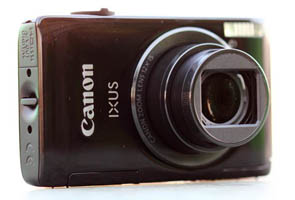- Home
- Cameras
- Cameras Reviews
- Review: Canon IXUS 1100HS
Review: Canon IXUS 1100HS
By Swapnil Mathur | Updated: 5 June 2012 17:27 IST

Click Here to Add Gadgets360 As A Trusted Source

Advertisement
Canon has recently been increasing its focus on consumer grade point-and-shoot cameras, with the aim to infuse higher end features into a slimmer form-factor. Their newest addition to this line-up is the Canon IXUS1100HS (known as the ELPH 510 in the US).
In the box
Canon IXUS 1100HS camera, SanDisk 4GB SD Card (Class 4), lanyard, user-manual, standard USB cable and a software CD.
Features
Measuring in at just .86 inches thick, the IXUS 1100HS houses a 12 megapixel back-illuminated sensor to give the best image quality possible. The 'HS' in the name stands for 'High Sensitivity' and represents a combination of a back-illuminated sensor along with Canon's Digic Image Processor that deliver great image quality even in low light.
The camera also packs a modest 12x optical zoom (28mm-336mm equivalent) in a rather slim package. The camera replaces the tradition stock of buttons at the back with a 3.2-inch LCD touch screen that can be used to access various functions and menus.
The IXUS 1100HS is SD, SDHC and SDXC compatible and offers output through a mini-HDMI port.
Performance
The IXUS 1100HS is a well-crafted point-and-shoot camera, with a solid metal body. We got our unit in a glossy black finish. The time between turning the camera on and taking our first shot was just about under 3 seconds, meaning that there is a good chance you won't be missing that decisive moment with the IXUS 1100HS.
The camera's menu system can be sorted into three categories; Settings, Functions and Menu. While in image capture mode, the camera displays a slew of settings pertaining to the shot such as flash settings, exposure compensation settings, a button to turn off the on-screen buttons, a button to access the functions menu and a button to start recording video.
The record button is a very handy feature for those who might want to switch from taking photos to shooting full HD video without wasting even a second. The 'Function' menu allows you to select various specific settings for focusing, white balancing, ISO, etc.
The IXUS 1100HS has a switch next to the power button that allows you to change to an automatic mode, where the camera automatically detects the environment and selects a photographic mode accordingly. This feature was rather effective in our testing, where we shot indoors, at a concert venue, in a playground and even in the mid-day sun. The camera was able to set the correct settings most of the times and deliver great images to us. This is a really helpful feature for those who might not be very familiar with photography related jargon and settings.
The IXUS 1100HS features two kinds of burst modes; regular and high speed that can be accessed through the shooting mode option. In regular burst mode, all one has to do is hold down the shutter and the camera will shoot up to 3 frames per second. In high-speed burst mode, the camera can shoot up to 7 frames per second, but drops the resolution down to just 3 megapixels.
The 12x optical zoom (with additional 2x digital zoom) functions exceptionally well, thanks to Canon's Image Stabilization (IS) system. The macro mode of the lens is something worth a mention here. When zoomed out all the way, the lens has a minimum focusing distance of about 0.4 inches However, when we zoomed in all the way, our minimum focusing distance increased drastically and we were not able to capture any macro-like (extreme close-up) shots. Despite this shortcoming, the camera always managed to focus on the right part of the image, thereby delivering well-exposed and vibrant images.
The screen on the IXUS 1100HS is something to talk about. Besides being a control interface and a digital viewfinder, the screen can also act as a shutter-button by simply tapping on it to take a photograph. The screen is very legible even under direct sunlight and shows rich, colorful previews of the images shot. To jump from one image to the next, you simply have to tap on the left or right edge of the screen.
One thing that we feel must be pointed out is the responsiveness of the screen. While modern day tablets and cellphones have made us used to screens that respond at the slightest touch, the screen on the Canon IXUS 1100HS requires a firmer touch to register commands. Another concern for us regarding the touchscreen was the fact that it slowed us down a little when I came to switching between modes and settings as we had to browse through several menu pages to get the to relevant parts. This is where the dials and physical buttons come in handy.
The battery life of the camera was a big letdown. A few minutes worth of HD videos and about 70 photos later, we found the camera showing a 'low battery' symbol flashing. It just so happens that the IXUS 1100HS runs off a battery that's rated for just 170 shots, under ideal conditions. However, our real world usage yielded a lower number and thus, we'd recommend getting a spare battery or two, just to make sure you never run out of juice.
Image Quality
Everything said and done, at the end of the day, what matters is image quality. We tested the camera in several shooting conditions and found the results to be a little mixed. When shooting under the bright mid-day sun, the camera captured colors fairly accurately with good contrast and detail. Image quality further improved when shooting in shade (to simulate overcast sky) as colors became more vibrant and sharper. Normally when you zoom in to the maximum range of the camera, the image quality takes a hit, but that wasn't the case with the IXUS 1100HS.
The other aspect of image quality comes from using the flash. Flash can be used either for close-up shots, medium distance shots (5-10 feet from the camera) or for shots where the subject is far away (10 feet and beyond). Photos shot using the flash for subjects up to 10 feet away from the camera came out well balanced, without the ambient light being over powered by the flash. However, when the subject distance went beyond 13 feet, the flash wasn't powerful enough to light up the scene well and caused out images to look slightly under-exposed.
The back-illuminated sensor does its job rather well, keeping the noise levels rather low when shooting. However, there are some visible signs of the camera applying noise-reduction to the image, so they lose some sharpness, but nothing that any common image editing software can't fix. Overall, it felt nice to be able to take shots at night that would have otherwise been next to impossible by a regular point-and-shoot.
The camera also boasts the ability to shoot full HD video. We tested out the video for quality and found the footage to be smooth and crisp, but if you were a quality Nazi, you could notice compression artifacts in the footage. The mono mic lends well to the high quality video for filming subjects that are close by or loud venues, but fails to record audio acceptably when the speaker is standing more than 15 feet or so away.
Verdict
The Canon IXUS 1100HS is a definitely a full-bodied camera that lives up to the 'point-and-shoot' moniker rather well. With a price tag of Rs. 18,995, the IXUS 1100HS finds itself placed in the mid-level segment for buyers (See: Buyer's guide for point-and-shoot cameras). Higher price than its competitor can be attributed to a back-illuminated sensor that allows for shots to be taken in very low light conditions without degrading the image quality.
While there are cameras in the same price range with a higher zoom range and more megapixels, the IXUS 1100HS does claim to be the world's slimmest with 12x optical zoom. The IXUS 1100HS is aimed at the kind of consumer who prioritizes compactness over the price, without compromising on the feature set.
To see how the Canon IXUS 1100HS looks and performs, visit our photo gallery.
Pros
A slim profile, making it easy to carry around
Back-Illuminated sensor for better low light photography
Long 12x optical zoom with Image Stabilization
Touch-screen shutter
Records images in various aspect ratios
Cons
Sluggish touch-screen
Expensive for the feature-set
Back screen prone to smudges
Battery has a meager rating of just 170 shots, which would be further reduced if shooting with flash
The high-speed burst mode shoots 7 frames per second, but reduces the resolution to just 3-megapixels
Rating
Performance: 3.5
Features: 4
Ease of use: 4
Ergonomics: 5
Wow Factor: 4
Value for Money: 3
Overall: 4
In the box
Canon IXUS 1100HS camera, SanDisk 4GB SD Card (Class 4), lanyard, user-manual, standard USB cable and a software CD.
Features
Measuring in at just .86 inches thick, the IXUS 1100HS houses a 12 megapixel back-illuminated sensor to give the best image quality possible. The 'HS' in the name stands for 'High Sensitivity' and represents a combination of a back-illuminated sensor along with Canon's Digic Image Processor that deliver great image quality even in low light.
The camera also packs a modest 12x optical zoom (28mm-336mm equivalent) in a rather slim package. The camera replaces the tradition stock of buttons at the back with a 3.2-inch LCD touch screen that can be used to access various functions and menus.
The IXUS 1100HS is SD, SDHC and SDXC compatible and offers output through a mini-HDMI port.
Performance
The IXUS 1100HS is a well-crafted point-and-shoot camera, with a solid metal body. We got our unit in a glossy black finish. The time between turning the camera on and taking our first shot was just about under 3 seconds, meaning that there is a good chance you won't be missing that decisive moment with the IXUS 1100HS.
The camera's menu system can be sorted into three categories; Settings, Functions and Menu. While in image capture mode, the camera displays a slew of settings pertaining to the shot such as flash settings, exposure compensation settings, a button to turn off the on-screen buttons, a button to access the functions menu and a button to start recording video.
The record button is a very handy feature for those who might want to switch from taking photos to shooting full HD video without wasting even a second. The 'Function' menu allows you to select various specific settings for focusing, white balancing, ISO, etc.
The IXUS 1100HS has a switch next to the power button that allows you to change to an automatic mode, where the camera automatically detects the environment and selects a photographic mode accordingly. This feature was rather effective in our testing, where we shot indoors, at a concert venue, in a playground and even in the mid-day sun. The camera was able to set the correct settings most of the times and deliver great images to us. This is a really helpful feature for those who might not be very familiar with photography related jargon and settings.
The IXUS 1100HS features two kinds of burst modes; regular and high speed that can be accessed through the shooting mode option. In regular burst mode, all one has to do is hold down the shutter and the camera will shoot up to 3 frames per second. In high-speed burst mode, the camera can shoot up to 7 frames per second, but drops the resolution down to just 3 megapixels.
The 12x optical zoom (with additional 2x digital zoom) functions exceptionally well, thanks to Canon's Image Stabilization (IS) system. The macro mode of the lens is something worth a mention here. When zoomed out all the way, the lens has a minimum focusing distance of about 0.4 inches However, when we zoomed in all the way, our minimum focusing distance increased drastically and we were not able to capture any macro-like (extreme close-up) shots. Despite this shortcoming, the camera always managed to focus on the right part of the image, thereby delivering well-exposed and vibrant images.
The screen on the IXUS 1100HS is something to talk about. Besides being a control interface and a digital viewfinder, the screen can also act as a shutter-button by simply tapping on it to take a photograph. The screen is very legible even under direct sunlight and shows rich, colorful previews of the images shot. To jump from one image to the next, you simply have to tap on the left or right edge of the screen.
One thing that we feel must be pointed out is the responsiveness of the screen. While modern day tablets and cellphones have made us used to screens that respond at the slightest touch, the screen on the Canon IXUS 1100HS requires a firmer touch to register commands. Another concern for us regarding the touchscreen was the fact that it slowed us down a little when I came to switching between modes and settings as we had to browse through several menu pages to get the to relevant parts. This is where the dials and physical buttons come in handy.
The battery life of the camera was a big letdown. A few minutes worth of HD videos and about 70 photos later, we found the camera showing a 'low battery' symbol flashing. It just so happens that the IXUS 1100HS runs off a battery that's rated for just 170 shots, under ideal conditions. However, our real world usage yielded a lower number and thus, we'd recommend getting a spare battery or two, just to make sure you never run out of juice.
Image Quality
Everything said and done, at the end of the day, what matters is image quality. We tested the camera in several shooting conditions and found the results to be a little mixed. When shooting under the bright mid-day sun, the camera captured colors fairly accurately with good contrast and detail. Image quality further improved when shooting in shade (to simulate overcast sky) as colors became more vibrant and sharper. Normally when you zoom in to the maximum range of the camera, the image quality takes a hit, but that wasn't the case with the IXUS 1100HS.
The other aspect of image quality comes from using the flash. Flash can be used either for close-up shots, medium distance shots (5-10 feet from the camera) or for shots where the subject is far away (10 feet and beyond). Photos shot using the flash for subjects up to 10 feet away from the camera came out well balanced, without the ambient light being over powered by the flash. However, when the subject distance went beyond 13 feet, the flash wasn't powerful enough to light up the scene well and caused out images to look slightly under-exposed.
The back-illuminated sensor does its job rather well, keeping the noise levels rather low when shooting. However, there are some visible signs of the camera applying noise-reduction to the image, so they lose some sharpness, but nothing that any common image editing software can't fix. Overall, it felt nice to be able to take shots at night that would have otherwise been next to impossible by a regular point-and-shoot.
The camera also boasts the ability to shoot full HD video. We tested out the video for quality and found the footage to be smooth and crisp, but if you were a quality Nazi, you could notice compression artifacts in the footage. The mono mic lends well to the high quality video for filming subjects that are close by or loud venues, but fails to record audio acceptably when the speaker is standing more than 15 feet or so away.
Verdict
The Canon IXUS 1100HS is a definitely a full-bodied camera that lives up to the 'point-and-shoot' moniker rather well. With a price tag of Rs. 18,995, the IXUS 1100HS finds itself placed in the mid-level segment for buyers (See: Buyer's guide for point-and-shoot cameras). Higher price than its competitor can be attributed to a back-illuminated sensor that allows for shots to be taken in very low light conditions without degrading the image quality.
While there are cameras in the same price range with a higher zoom range and more megapixels, the IXUS 1100HS does claim to be the world's slimmest with 12x optical zoom. The IXUS 1100HS is aimed at the kind of consumer who prioritizes compactness over the price, without compromising on the feature set.
To see how the Canon IXUS 1100HS looks and performs, visit our photo gallery.
Pros
A slim profile, making it easy to carry around
Back-Illuminated sensor for better low light photography
Long 12x optical zoom with Image Stabilization
Touch-screen shutter
Records images in various aspect ratios
Cons
Sluggish touch-screen
Expensive for the feature-set
Back screen prone to smudges
Battery has a meager rating of just 170 shots, which would be further reduced if shooting with flash
The high-speed burst mode shoots 7 frames per second, but reduces the resolution to just 3-megapixels
Rating
Performance: 3.5
Features: 4
Ease of use: 4
Ergonomics: 5
Wow Factor: 4
Value for Money: 3
Overall: 4
Comments
Get your daily dose of tech news, reviews, and insights, in under 80 characters on Gadgets 360 Turbo. Connect with fellow tech lovers on our Forum. Follow us on X, Facebook, WhatsApp, Threads and Google News for instant updates. Catch all the action on our YouTube channel.
Related Stories
Popular on Gadgets
- Samsung Galaxy Unpacked 2025
- ChatGPT
- Redmi Note 14 Pro+
- iPhone 16
- Apple Vision Pro
- Oneplus 12
- OnePlus Nord CE 3 Lite 5G
- iPhone 13
- Xiaomi 14 Pro
- Oppo Find N3
- Tecno Spark Go (2023)
- Realme V30
- Best Phones Under 25000
- Samsung Galaxy S24 Series
- Cryptocurrency
- iQoo 12
- Samsung Galaxy S24 Ultra
- Giottus
- Samsung Galaxy Z Flip 5
- Apple 'Scary Fast'
- Housefull 5
- GoPro Hero 12 Black Review
- Invincible Season 2
- JioGlass
- HD Ready TV
- Laptop Under 50000
- Smartwatch Under 10000
- Latest Mobile Phones
- Compare Phones
Latest Gadgets
- Honor Win RT
- Honor Win
- Xiaomi 17 Ultra Leica Edition
- Xiaomi 17 Ultra
- Huawei Nova 15
- Huawei Nova 15 Pro
- Huawei Nova 15 Ultra
- OnePlus 15R
- Asus ProArt P16
- MacBook Pro 14-inch (M5, 2025)
- OPPO Pad Air 5
- Huawei MatePad 11.5 (2026)
- Xiaomi Watch 5
- Huawei Watch 10th Anniversary Edition
- Acerpure Nitro Z Series 100-inch QLED TV
- Samsung 43 Inch LED Ultra HD (4K) Smart TV (UA43UE81AFULXL)
- Asus ROG Ally
- Nintendo Switch Lite
- Haier 1.6 Ton 5 Star Inverter Split AC (HSU19G-MZAID5BN-INV)
- Haier 1.6 Ton 5 Star Inverter Split AC (HSU19G-MZAIM5BN-INV)
© Copyright Red Pixels Ventures Limited 2025. All rights reserved.
















